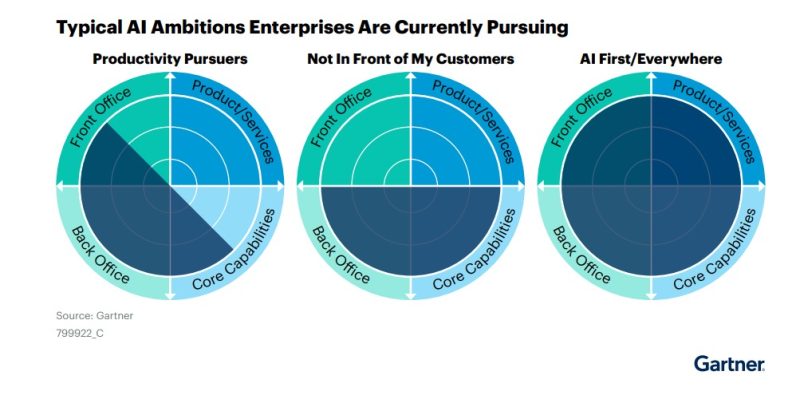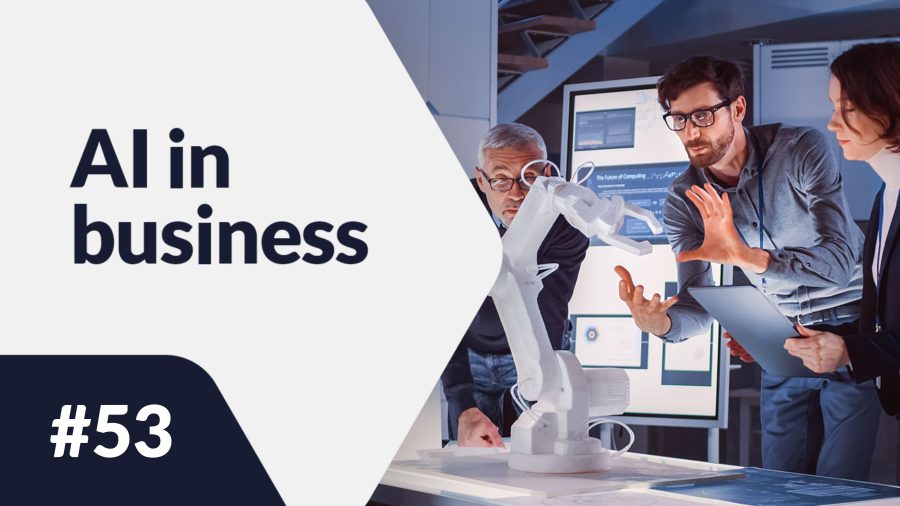Do you know what skills and personalities are needed in an AI team? In today’s article, we’ll take a look at what the AI team looks like, discussing competencies, personalities, work breakdown structure, and responsibilities. Read on.
AI team – table of contents:
What does the AI team do?
The AI team is a group of specialists in the field of artificial intelligence. Their responsibilities within the company include:
- strengthening products and services using AI — the AI team can develop and implement AI-based systems that enhance the value of the products and services offered. For example, an e-commerce company can deploy an AI-based recommendation system that suggests products tailored to customer preferences based on an analysis of shopping behavior,
- automating routine tasks — the AI team can create solutions that automate repetitive tasks, allowing employees to focus on more complex ones. For example, a company can create an AI-based chatbot to provide customer service and answer frequently asked questions,
- analyzing data and generating reports — the AI team can analyze large amounts of data, draw conclusions, and generate reports to support business decisions. For example, a company can use an AI-based sentiment analysis system to monitor customer feedback on its products and services.
However, the responsibilities of a company’s AI team depend primarily on the organization’s ambitions regarding the scope of artificial intelligence deployment. According to Gartner, the scope of AI use in the enterprise can be broadly categorized into three areas:
- Companies seeking to improve efficiency, where the AI team works primarily to prepare both internal tools for the organization and tools for customer service.
- Companies that use AI to optimize their operations, but avoid using it in products and customer service. The AI team is only concerned with improving an organization’s internal processes.
- Companies that are implementing artificial intelligence on a large scale, where the AI team implements solutions in products, customer service, and internally.

Source: Gartner (https://www.gartner.com/en/information-technology/insights/it-symposium-keynote)
Competencies and responsibilities of AI team members
According to Gartner’s “Gartner Top 10 Strategic Technology Trends 2024” report, the demand for artificial intelligence specialists will grow in the coming years, especially in areas, such as:
- implementing generative artificial intelligence in companies,
- AI trust, Risk and Security Management, AI TRISM,
- creating and developing AI-enabled applications (AI-augmented development),
- using artificial intelligence to optimize the way decisions are made.
But what does an AI team look like internally? Of course, it will vary slightly depending on the project. But here are some key roles in the AI team:
- Data scientist — data scientists deal with data analysis and interpretation, predictive modeling, and machine learning. Their main goal is to extract valuable information from data and use it to make business decisions.
- AI software engineer — AI software engineers create and develop applications based on artificial intelligence. Their job is to implement and optimize machine learning algorithms and integrate them into existing systems.
- ML researcher/ML engineer — ML researchers develop new machine learning models and algorithms and implement them. Their main goal is continuous improvement and innovation in the field of artificial intelligence.
- AI ethicist— AI ethicists are professionals who understand the risks associated with using artificial intelligence and are responsible for the ethical application of this technology. They ensure that AI initiatives and their implementation comply with ethical principles and the law.
The AI team also needs someone responsible for the strategic and business aspects of the project. This could be an AI manager, who manages the development and implementation of AI-based processes and products, or a chief AI officer (CAIO), who is responsible for AI strategy across the organization. Their role is to:
- manage the AI technologies used – the CAIO must be familiar with various AI algorithms and techniques and be able to apply them to solve problems in an organization,
- oversee the design, development, testing, and implementation of AI solutions in collaboration with the AI team,
- measure the business and financial impact of AI to assess the benefits and costs of implementing artificial intelligence,
- train and develop employees in AI.
Personalities in the AI team
As in any close-knit team, each member of the AI team must have the right competencies, regularly updated skills, and experience. No less important, however, is the need for diversity, meaning that the team should consist not so much of similar people as of people who inspire each other with their different points of view.
Personalities play a key role in building an effective AI team. While all team members share a passion for technology and analytical skills, they differ in their approach, temperament, and preferences.
The AI team manager must recognize these differences and appreciate the importance of diversity. For example, a detail-oriented and meticulous data scientist may be bored by abstract discussions about the future directions of AI technology and prefer to focus on improving the current ML model. On the other hand, the AI ethicist with a visionary temperament and a rich imagination may not have the patience for tedious programming and testing.
According to McKinsey’s “Technology Trends Outlook 2023” report, the following are increasingly important in today’s business world:
- Flexibility – the speed at which technology is evolving means it is not worth getting locked into one set of tools or one way of doing things,
- Ability to adapt to changing conditions – changes in team composition, a shift to remote work, or even outsourcing to another company should not be a problem for the “ideal” AI team member,
- Openness to new challenges – implementing artificial intelligence in more areas of the business means that each person on the AI team will need to acquire new skills.
Equally important are the ability to cooperate and communicate, the willingness to take responsibility for assigned tasks, and the ability to handle stress.

Source: DALL·E 3, prompt: Marta M. Kania (https://www.linkedin.com/in/martamatyldakania/)
Work breakdown structure
To ensure effective workflow in the AI team, it is worth using the work breakdown structure technique. It involves dividing the project into more detailed tasks, which are then assigned to individual team members according to their competencies.
At the highest level, there are overall business goals, which are broken down into specific product initiatives. These, in turn, are divided into research, programming, testing tasks, etc. Thanks to WBS, everyone knows exactly what to do to contribute to the success of the whole.
In the AI team, the work breakdown structure may look like this:
- Data analysis. The AI team often begins by analyzing data to identify patterns and relationships that can be used to build predictive models.
- Building predictive models. Based on the collected data, the AI team builds predictive models that can be used to forecast future events.
- Testing and optimizing models. Once the models are built, the AI team tests and optimizes them to make sure they work properly and produce accurate results.
- Implementing models. After testing, models are implemented, which means they are used to predict future events based on new data.
- Monitoring and maintaining models. Once the models are implemented, the team monitors their performance and keeps them in good shape to ensure accurate results throughout their lifetime.
Summary
The choice of the project team can determine the success or failure of the entire project. That’s why it’s so important that the AI team consists of people with various skills and personalities, different experiences, and different working styles. If the project manager or CAIO chooses the right people, they will naturally take on informal roles that are most important for building a cohesive team, increasing the chances of success and further fruitful collaboration.

If you like our content, join our busy bees community on Facebook, Twitter, LinkedIn, Instagram, YouTube, Pinterest, TikTok.
Author: Robert Whitney
JavaScript expert and instructor who coaches IT departments. His main goal is to up-level team productivity by teaching others how to effectively cooperate while coding.
AI in business:
- Threats and opportunities of AI in business (part 1)
- Threats and opportunities of AI in business (part 2)
- AI applications in business - overview
- AI-assisted text chatbots
- Business NLP today and tomorrow
- The role of AI in business decision-making
- Scheduling social media posts. How can AI help?
- Automated social media posts
- New services and products operating with AI
- What are the weaknesses of my business idea? A brainstorming session with ChatGPT
- Using ChatGPT in business
- Synthetic actors. Top 3 AI video generators
- 3 useful AI graphic design tools. Generative AI in business
- 3 awesome AI writers you must try out today
- Exploring the power of AI in music creation
- Navigating new business opportunities with ChatGPT-4
- AI tools for the manager
- 6 awesome ChatGTP plugins that will make your life easier
- 3 grafików AI. Generatywna sztuczna inteligencja dla biznesu
- What is the future of AI according to McKinsey Global Institute?
- Artificial intelligence in business - Introduction
- What is NLP, or natural language processing in business
- Automatic document processing
- Google Translate vs DeepL. 5 applications of machine translation for business
- The operation and business applications of voicebots
- Virtual assistant technology, or how to talk to AI?
- What is Business Intelligence?
- Will artificial intelligence replace business analysts?
- How can artificial intelligence help with BPM?
- AI and social media – what do they say about us?
- Artificial intelligence in content management
- Creative AI of today and tomorrow
- Multimodal AI and its applications in business
- New interactions. How is AI changing the way we operate devices?
- RPA and APIs in a digital company
- The future job market and upcoming professions
- AI in EdTech. 3 examples of companies that used the potential of artificial intelligence
- Artificial intelligence and the environment. 3 AI solutions to help you build a sustainable business
- AI content detectors. Are they worth it?
- ChatGPT vs Bard vs Bing. Which AI chatbot is leading the race?
- Is chatbot AI a competitor to Google search?
- Effective ChatGPT Prompts for HR and Recruitment
- Prompt engineering. What does a prompt engineer do?
- AI Mockup generator. Top 4 tools
- AI and what else? Top technology trends for business in 2024
- AI and business ethics. Why you should invest in ethical solutions
- Meta AI. What should you know about Facebook and Instagram's AI-supported features?
- AI regulation. What do you need to know as an entrepreneur?
- 5 new uses of AI in business
- AI products and projects - how are they different from others?
- AI-assisted process automation. Where to start?
- How do you match an AI solution to a business problem?
- AI as an expert on your team
- AI team vs. division of roles
- How to choose a career field in AI?
- Is it always worth it to add artificial intelligence to the product development process?
- AI in HR: How recruitment automation affects HR and team development
- 6 most interesting AI tools in 2023
- 6 biggest business mishaps caused by AI
- What is the company's AI maturity analysis?
- AI for B2B personalization
- ChatGPT use cases. 18 examples of how to improve your business with ChatGPT in 2024
- Microlearning. A quick way to get new skills
- The most interesting AI implementations in companies in 2024
- What do artificial intelligence specialists do?
- What challenges does the AI project bring?
- Top 8 AI tools for business in 2024
- AI in CRM. What does AI change in CRM tools?
- The UE AI Act. How does Europe regulate the use of artificial intelligence
- Sora. How will realistic videos from OpenAI change business?
- Top 7 AI website builders
- No-code tools and AI innovations
- How much does using AI increase the productivity of your team?
- How to use ChatGTP for market research?
- How to broaden the reach of your AI marketing campaign?
- "We are all developers". How can citizen developers help your company?
- AI in transportation and logistics
- What business pain points can AI fix?
- Artificial intelligence in the media
- AI in banking and finance. Stripe, Monzo, and Grab
- AI in the travel industry
- How AI is fostering the birth of new technologies
- The revolution of AI in social media
- AI in e-commerce. Overview of global leaders
- Top 4 AI image creation tools
- Top 5 AI tools for data analysis
- AI strategy in your company - how to build it?
- Best AI courses – 6 awesome recommendations
- Optimizing social media listening with AI tools
- IoT + AI, or how to reduce energy costs in a company
- AI in logistics. 5 best tools
- GPT Store – an overview of the most interesting GPTs for business
- LLM, GPT, RAG... What do AI acronyms mean?
- AI robots – the future or present of business?
- What is the cost of implementing AI in a company?
- How can AI help in a freelancer’s career?
- Automating work and increasing productivity. A guide to AI for freelancers
- AI for startups – best tools
- Building a website with AI
- OpenAI, Midjourney, Anthropic, Hugging Face. Who is who in the world of AI?
- Eleven Labs and what else? The most promising AI startups
- Synthetic data and its importance for the development of your business
- Top AI search engines. Where to look for AI tools?
- Video AI. The latest AI video generators
- AI for managers. How AI can make your job easier
- What’s new in Google Gemini? Everything you need to know
- AI in Poland. Companies, meetings, and conferences
- AI calendar. How to optimize your time in a company?
- AI and the future of work. How to prepare your business for change?
- AI voice cloning for business. How to create personalized voice messages with AI?
- Fact-checking and AI hallucinations
- AI in recruitment – developing recruitment materials step-by-step
- Midjourney v6. Innovations in AI image generation
- AI in SMEs. How can SMEs compete with giants using AI?
- How is AI changing influencer marketing?
- Is AI really a threat to developers? Devin and Microsoft AutoDev
- AI chatbots for e-commerce. Case studies
- Best AI chatbots for ecommerce. Platforms
- How to stay on top of what's going on in the AI world?
- Taming AI. How to take the first steps to apply AI in your business?
- Perplexity, Bing Copilot, or You.com? Comparing AI search engines
- ReALM. A groundbreaking language model from Apple?
- AI experts in Poland
- Google Genie — a generative AI model that creates fully interactive worlds from images
- Automation or augmentation? Two approaches to AI in a company
- LLMOps, or how to effectively manage language models in an organization
- AI video generation. New horizons in video content production for businesses
- Best AI transcription tools. How to transform long recordings into concise summaries?
- Sentiment analysis with AI. How does it help drive change in business?
- The role of AI in content moderation


















